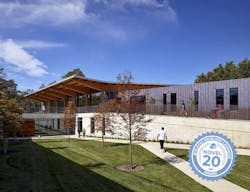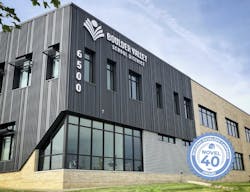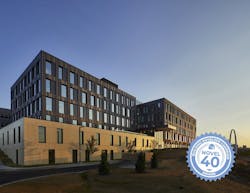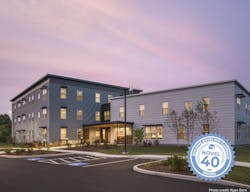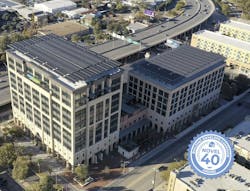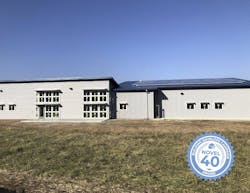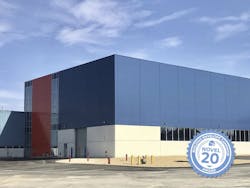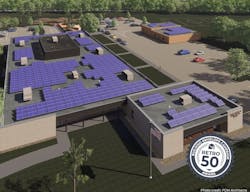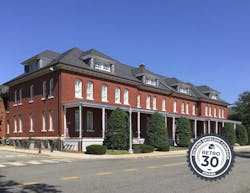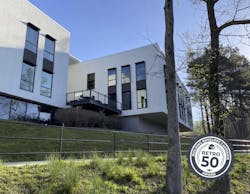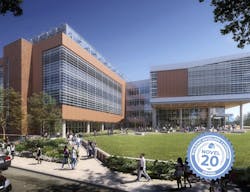14 projects recognized by DOE for high-performance building envelope design
Boulder Community Health’s West Medical Building, with its hybrid vacuum-insulated glass installation and two inches of continuous rigid insulation, and the Lubber Run Community Center, Arlington, Va., with its "thermomass" insulated concrete walls, are among 14 projects to be recognized by the U.S. Department of Energy (DOE) for their high-performance building envelope design.
These projects represent the inaugural class of DOE's Better Buildings Building Envelope Campaign (BEC) program, which was launched in 2020 to honor building teams for their leadership in envelope performance.
Organizations are eligible for recognition in four categories:
- Novel 40 - new construction envelope projects that achieve 40 percent above a code baseline
- Novel 20 - new construction envelope projects that achieve 20 percent above a code baseline
- Retro 50 - retrofit projects that achieve 50 percent improvement
- Retro 30 - retrofit projects that achieve 30 percent improvement
The BEC program also recognizes:
- Role Models – buildings that meet one of the recognition tiers and also incorporate an additional advanced strategy or technology into their building envelopes, serving as role models within the industry
- Honorable Mentions – buildings that do not meet a recognition tier but are still deserving of recognition.
Let's take a look at the 2021 Better Buildings Building Envelope Campaign honorees (project descriptions and stats courtesy DOE's BEC program):
Boulder Community Health’s West Medical Building, Lafayette, Colo.
Novel 40 Role Model winner
Description:
Boulder Community Health’s newest medical office building supports an eye clinic and an ambulatory surgery center for a leading Colorado retina practice. Energy-efficient design elements include masonry walls with 2 inches of continuous rigid insulation complemented by R-19 batt within the stud cavity, exceeding code requirements, and a canopy on the building’s south entrance that will accommodate a 99 kW photovoltaic array in the future.
This building showcases emerging hybrid vacuum-insulated glass (HIVG) technology, which improves year-round energy efficiency and comfort by reducing thermal transmittance and convection at the windows. In contrast to the U-value of 0.29 for low-emissivity insulated glass, the HVIG used on the project has a U-value of 0.071 on the north façade and 0.064 on the others. The HVIG also allowed for a 13% reduction in visible light transmittance, decreasing glare on façades with higher solar radiation.
The Building Envelope Campaign technical team assisted Boulder Associates by calculating the fenestration values of the standard thermally broken aluminum frames used in this project, as the center-of-glass U-values for the HVIG were atypical.
Performance data:
Size: 29,652 sf
kBTU/year saved: 266,417.1
BEP value: 10.8
BEP improvement: 46 percent
Submitting firm: Boulder Associates
American Geophysical Union, Washington, D.C.
Retro 50 winner
Description:
The American Geophysical Union (AGU) considers its seven-story headquarters building a “living laboratory.” When the 1994-built building’s mechanical system began to fail several years ago, AGU chose to renovate with the goal of becoming Washington, D.C.'s first net-zero commercial renovation. Nearly 100% of the building shell was reused.
AGU is working toward an annual energy use intensity of 13, far below the target for AGU’s climate zone. Window glazing was applied at the front of the building, and photovoltaics and a green roof were installed. The building was insulated with new studs and closed-cell spray insulation, leading to a 15.7 R-value. The roof has an R-value of 30, and windows and associated assembly have a 0.23 U-value. Triple-pane, air-filled, dynamic glass windows utilize electrochromic film for on-demand tinting to optimize solar gains.
The building features a dedicated outdoor air system tied to a hydroponic phytoremediation wall and air quality monitor, DC-powered lights and workstations, storm water reuse, radiant cooling, and a municipal waste water system that moves water to an exchange system that absorbs energy from the water, reducing dependence on a chiller.
Performance data:
Size: 71,486 sf
kBTU/year saved: 930,021.4
BEP value: 19.7
BEP improvement: 50+ percent
Submitting firm: American Geophysical Union
Lubber Run Community Center, Arlington, Va.
Novel 20 winner
Description:
The Lubber Run Community Center acts as a link between the city and nature. The concrete and timber building is rooted to the 4.5-acre site with a sculptural plinth and iconic roof. To maximize open space, green space is elevated to cover belowground parking and program spaces. The project’s net-zero design features an airtight, high-performance, cost-efficient envelope. Cast-in-place concrete, copper cladding, and a Thermomass system contribute to a sustainable design.
The Thermomass system mitigates the environmental impact of the original concrete by embedding insulation within a mass wall to improve performance. Rock wool insulation resists humidity buildup and is more environmentally friendly than plastic-based insulation. Concrete used on the project employs CO2 injection, which sequesters CO2, reduces the concrete’s embodied energy, and improves strength.
Challenges included holes found in the air and moisture barriers during air infiltration tests, many at attachment points for girts supporting the copper cladding. Infiltration tests highlighted the need to check attachment point sealing prior to covering the points with siding.
Performance data:
Size: 56,425 sf
kBTU/year saved: 182,683.2
BEP value: 11.8
BEP improvement: 21 percent
Submitting firm: Arlington County Parks and Recreation
Boulder Valley School District BVSD Education Center, Boulder, Colo.
Novel 40
Description:
The BVSD Education Center comprises a series of buildings originally constructed in 1963, with the latest addition completed in 1983. BVSD conducted Owner's Project Requirements + Basis of Design and detailed energy and performance analyses for proposed wall and roof assemblies.
Workspaces were configured for flexible collaboration, and one side of the building was demolished and replaced with a two-story addition with a reduced footprint that allows for more parking. The exterior wall assemblies were constructed using a DuPont Thermax wall system, which was sealed to itself. All transitions from the Thermax system to adjacent materials were sealed, particularly windows and doors, top of wall to roof, and base of wall to foundation.
These improvements addressed a range of structural deficiencies including substandard code compliance; degraded building exterior; inefficient windows; roofs and boilers at the end of their service life; and workspaces configured as single-occupant spaces with permanent walls, which made for an inefficient use of space with limited functional flexibility.
Performance data:
Size: 43,043 sf
kBTU/year saved: 297,230.5
BEP value: 8.1
BEP improvement: 46 percent
Submitting firm: Boulder Valley School District
Catalyst Building, Spokane, Wash.
Novel 40
Description:
The Catalyst Building is a mixed-use office and higher education building in the South Landing Eco-District, which employs high-efficiency equipment with thermal sharing and storage capabilities from the neighboring buildings it serves.
The zero-energy, zero-carbon building demonstrates high performance and sustainability through all aspects of its design. The building envelope maximizes thermal performance while utilizing sustainable materials, with cross-laminated timber throughout, as well as exterior insulation and triple-pane windows.
The cross-laminated timber used in the Catalyst Building largely contributes to its zero-carbon design. The custom triple-pane windows and highly insulated walls and roofs minimize thermal interruption. The airtight building design achieves infiltration rates that exceed the Passive House standard.
Significant coordination was required for performance analysis and design throughout all the building systems. The building required extensive envelope analysis to understand the performance of the building assemblies and identify any potential points of thermal bridging.
Performance data:
Size: 160,000 sf
kBTU/year saved: 1,018,759.7
BEP value: 8.2
BEP improvement: 56 percent
Submitting firm: McKinstry
Vergennes Community Housing, Vergennes, Vt.
Novel 40
Description:
Vergennes Community Housing is a newly constructed, mixed-income, multifamily rental property with 24 apartments and indoor and outdoor amenities. The development was designed with a passive house air sealing target, native plantings, and low-flow fixtures.
A fresh air ventilation system, low-VOC (volatile organic compound) finishes, and passive daylighting strategies were applied. To improve energy use, an electric vehicle charging station is available, photovoltaics are exploited, and LED lighting and triple-glazed windows were used in the construction. Additionally, the property has a heat recovery ventilation system and a high-performance mechanical system.
Vergennes is a walkable/bikeable site that has a community gathering space, infill development, and access to public transportation. The property was constructed with a durable design and materials to meet Efficiency Vermont’s high-performance standard for multifamily housing.
Resulting from the collaboration of a diverse team of passionate experts, this development incorporates the needs of residents, the community, and the environment.
Performance data:
Size: 23,500 sf
kBTU/year saved: 240,213.2
BEP value: 6.3
BEP improvement: 66 percent
Submitting firm: Evernorth
Credit Human Headquarters, San Antonio, Texas
Novel 40
Description:
Credit Human, a federal credit union chartered in 1935, opened its new headquarters building in 2021. The 12-story podium-style tower was developed as part of a two-building Class A office complex. The new building sets a local precedent for continued urban growth that recognizes San Antonio’s architectural history.
Energy- and water-saving strategies reduce the electricity and potable water needed from local utilities by approximately 97 percent. Strategies include a hybrid geothermal loop cooling/heating system, a 1-megawatt photovoltaic system, a water-cooled variable refrigerant flow HVAC system, a rainwater harvesting and condensate collection system, advanced plug load controls, and a high-performing building envelope. Airtightness is 0.088 cfm/sq ft @75 PA.
Credit Human’s goals included achieving LEED Platinum-certified status, designating the structure as a green building. The building incorporates high-performance glass and positioned large systems of glazed windows back from the face of the upper levels to minimize solar gain. Thermal breaks in window assemblies and envelope penetrations were carefully coordinated. Regular envelope testing and simulations were crucial to achieving a high-performing building.
Performance data:
Size: 216,946 sf
kBTU/year saved: 844,357.6
BEP value: 8.7
BEP improvement: 47 percent
Submitting firm: Credit Human Federal Credit Union
Athens County EMS Station, Athens, Ohio
Novel 40
Description:
EMS Station #51 serves as a regional example of net-zero and energy-efficient construction. The building uses 80% less energy than a standard construction before the addition of active renewables, which increase the building’s efficiency.
The addition of a 48,000 annual-kilowatt-hour photovoltaic array, inverters, and rack system reduced monthly electricity costs by 78 percent. Additionally, envelope improvements reduced reduced heating, ventilation, and air conditioning (HVAC) system needs and resulted in significant HVAC savings.
The project achieved R-51.23 roof insulation and R-27.85 wall insulation, well above the code minimum requirements. For underslab insulation, a concrete slab was applied over vapor retarder over two layers of 3-inch EPS foam. Fiberglass-frame, insulated, glazed, nonoperable windows achieved a U-value of 0.22. Aluminum shading devices on the windows provide 100 percent shading in the summer.
The project contractors were local and had limited experience with sustainable/net-zero construction, which affected the project design approach. The project team worked with tight budget constraints, and special attention was focused on airtightness targets.
Performance data:
Size: 8,726 sf
kBTU/year saved: 90,321
BEP value: 5.0
BEP improvement: 52 percent
Submitting firm: Athens (Ohio) County
Fermilab Industrial Center Building Addition, Batavia, Ill.
Novel 20
Description:
Fermilab’s Industrial Center Building Addition (ICB-A) connects the floor areas of two existing facilities, to reduce the exterior building envelope and embrace the guiding principles established in the 2018 Fermilab Campus Master Plan. This building constitutes the first steps toward centralizing activities, executing the planned expansion, and providing improved access and circulation for the buildings in the industrial complex.
The additional high bay assembly area with 40-ton bridge crane will help meet commitments to build cryomodules—~10 m-long structures containing superconducting magnets or cavities—which are used to manipulate charged particle beams in accelerators at Fermilab and partnering institutions. The space has already begun to be used for assembling cryomodules for the High-Luminosity Large Hadron Collider Accelerator Upgrade Project. There will also be a low bay workbench area dedicated to quantum science. A mezzanine space will be available for a future office build-out.
Challenges and barriers to connecting the facilities included the need to maintain daily building operations at existing buildings while sections of the roof structures were reinforced to accommodate snowdrift loads and to integrate building systems such as fire alarm systems.
Performance data:
Size: 24,921 sf
kBTU/year saved: 168,693.2
BEP value: 15.3
BEP improvement: 25 percent
Submitting firm: Fermi National Accelerator Laboratory
Prairie Trails School, Mt. Prospect, Ill.
Retro 50
Description:
Prairie Trails School, a single-story primary school originally built in 1966, recently incorporated several upgrades into the building envelope. A new thermally broken rail system with new insulation was applied to the exterior wall system, and new fiber cement wall cladding was installed over the new framing.
The original single-pane aluminum window system was replaced with a new double thermally broken curtain wall framing system with triple-pane dual low-emissivity insulated glazing. The existing roof system was replaced, and the roof insulation performance value was increased from code minimum R-30 to R-65 using polyisocyanurate foam board insulation. Additionally, the entire building perimeter was excavated, and new foundation insulation was installed to reduce thermal transfer below grade.
Challenges included exposure to winter weather and the need to adjust the PHIUS+ certification process, which was designed for residential applications, to accommodate school facilities. The design team, owner, and contractor also had to take training courses to understand and satisfy PHIUS+ certification requirements. Additionally, local companies were inexperienced with blower door certification.
Performance data:
Size: 28,737 sf
kBTU/year saved: 1,120,743
BEP value: 8.9
BEP improvement: 69 percent
Submitting firm: FGM Architects
Building 246, Arlington, Va.
Retro 30
Description:
Originally constructed in the 1880s, Building 246 is home to the Regimental Orientation Program for the Third US Infantry Regiment (The Old Guard), the Army’s oldest active-duty infantry unit. The Building 246 building envelope was modernized to outperform current energy code while leaving the historic fabric of the envelope untouched. Window U-value, opaque wall R-value, thermal comfort, and other elements were improved. Heat gain and moisture accumulation were mitigated.
The existing historic windows were backed with new double-pane, insulated windows and thermally broken frames that improved the performance of the window assembly to 40 percent beyond code requirements. The exterior walls were renovated with R-22 of continuous insulation behind the existing solid masonry façade, which achieved a 50% improvement beyond code requirements.
The roof was modernized to include continuous insulation and an air space for venting hot air, improving comfort in the occupied attic spaces. LED lighting and variable-drive fan coil units were also incorporated.
Performance data:
Size: 52,500 sf
kBTU/year saved: 812,230.5
BEP value: 13.9
BEP improvement: 47 percent
Submitting firm: EYP
ASHRAE World Headquarters, Peachtree Corners, Ga.
Retro 50
Description:
The American Society of Heating, Refrigerating and Air-Conditioning Engineers world headquarters building is located on 11 acres near Atlanta. Built in 1978 and with ongoing renovations begun in 2020, the building consists of four wings with concrete slab floors and floor beams and precast concrete panels for the exterior walls. Challenges included a hard move-out date to enable a new tenant to take possession of the old headquarters building.
New XPS insulation with drainage grooves and stucco finish was added to create R-17 exterior walls. The building window-to-wall ratio was also reduced to 33.5% for east and west, and 41.9% for north and south. A large all-glass lobby was replaced with a flat lobby roof with three translucent skylights.
Spray insulation was applied on the structural and acoustic decking, resulting in a total insulation value of R-35. Eighteen translucent skylights were installed in the east and west wing roofs, where most of the staff work in open office space.
The building’s new meeting center features classrooms with automated blinds and access to a large deck area overlooking the lake. An outdoor sidewalk between two wings was enclosed to provide the option of bringing order fulfillment in-house.
Performance data:
Size: 66,700 sf
kBTU/year saved: 320,376.7
BEP value: 6.7
BEP improvement: 60 percent
Submitting firm: ASHRAE
Plant Sciences Building, North Carolina State University, Raleigh, N.C.
Novel 20
Description:
The Plant Sciences Building is a new platform for interdisciplinary research in the heart of North Carolina State University’s Centennial Campus. Throughout the building, polyisocyanurate insulation thicknesses meet and exceed code requirements for wall assemblies. The insulation was installed outboard of the sheathing, which is wrapped in a fluid-applied vapor-permeable air barrier.
Glazing and thermally improved opaque assemblies are provided where beneficial. Brick cavity wall assemblies and terra cotta and composite panel back-ventilated rainscreens are supported by thermally broken ties and rail systems to reduce conductivity.
The project team and university architect selected glazing that met solar heat gain performance code requirements without a visual color shift. Shading devices were provided to the majority of the building’s glass surfaces, mounted outboard of the curtain wall. The airfoil shade profiles were parametrically tuned to provide occupant views of the campus while blocking direct sunlight.
Thermal conductivity was a major concern where structural elements could be exposed to exterior conditions. The project team used intumescent and fluid-applied insulation coatings to provide a thermal break along with the requisite passive fire protection.
Performance data:
Size: 179,846 sf
kBTU/year saved: 752,149.5
BEP value: 13.6
BEP improvement: 31 percent
Submitting firm: Flad Architects
Vermeer Plant 7, Pella, Iowa
Novel 20
Description:
Vermeer Plant 7, rebuilt and expanded in 2018 following a tornado, is a brightly lit world-class manufacturing space that provides improved air quality and safety. The 507,000-square-foot space within Vermeer’s manufacturing facility contains three paint lines, a manufacturing floor, and break areas with healthy food options.
The company’s main challenge involved construction during winter. The cold weather necessitated the use of mechanical fasteners rather than the optimal fully adhered fasteners. The plant’s walls are constructed from 12-inch-thick concrete and foam precast panels. Pella windows were installed in every wall panel to allow for natural light. The windows are also double-pane insulated with aluminum framing to reduce heat transfer.
The plant’s roof is made of metal decking, 5 inches of foam (R-30), half-inch Hardie board, and rubber membrane; this reinforced construction allows for safer walking on the roof. An air diffuser system, designed in-house and patent pending, cools the plant and filters weld smoke and other pollutants. Hazardous waste is either processed for reuse or used for fuel.
Performance data:
Size: 507,000 sf
kBTU/year saved: 1,784,544
BEP value: 11.6
BEP improvement: 20 percent
Submitting firm: Vermeer Corporation



